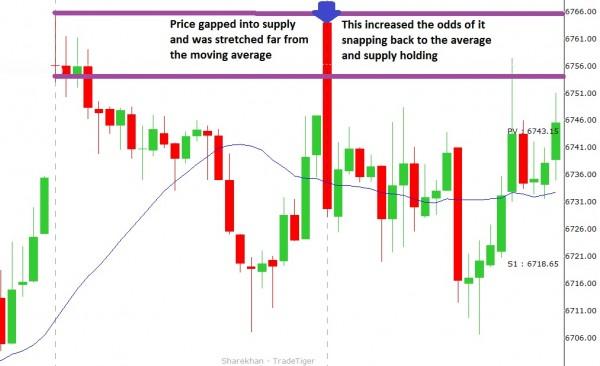Most traders are familiar with moving averages. They are a useful technical tool for identifying the direction and strength of a trend. However, many traders overlook a very useful characteristic of price that allows us to identify a trading opportunity using moving averages. That characteristic is elasticity.
Prices are elastic. They will move away from an average and then snap back. They repeat this process in a trend over and over, stretching away from that average before returning. In a trend, however, the average will slowly move in the direction of the trend thus making the price cover less distance when retracing.
Imagine a rubber band. If you stretch the band slightly, it will snap back to its original shape. If you stretch the band further, you will have a more violent snap back to the original shape. Price acts in a similar manner. If you observe price stretching away from an average, it will snap back as soon as it strikes a level of supply or demand. Stretch price further, such as a parabolic move, and you will often experience a stronger return.
This elasticity is due to the actions and emotions of the people trading and investing in the stock/commodity/index/currency. It works the same on any security. If you go to the store and your favorite product is marked down on sale, you are more likely to buy it or even buy more of it. If inflation caused the price of the product to rise, you may buy less of it, not buy it at all, or look for a substitute to buy.
The same occurs with securities. When price is below the average price, it is undervalued and a bargain. If it moves to an extreme away from the average then it becomes irresistible to traders and investors who will rush in to buy it and send the price higher. The traders will stop buying when it reaches the average price since it is no longer a bargain. However, those who missed out on the initial buying spree may try to join and will push prices above the average. If prices extend too far above an average, then the price is overvalued and no one will want to buy it. Nervous holders of the security will start to sell and cause prices to drop to… you guessed it, the average.
In the chart, I have used a simple moving average to demonstrate this effect. Note how price will move away from the average and then return after reaching extremes. We can locate high probability long and short entries when this is combined with support and resistance. Typically, when price stretches away from the average, it will extend until it reaches a supply or demand level. These are levels where traders caused the price to reverse in the past. The over or undervalued nature of price being far from the average, added to the fact that the price has reached a level where it turned previously will usually lead traders to take that action again.
This gives us the opportunity to predict where traders will take action and more importantly, where we can profit by acting sooner. There are some important rules that you must keep in mind when trading. Always be mindful of the trend and do not trade against it. For instance, you shouldn’t buy in downtrends. Look to short or close shorts until you have confirmed the trend is reversing. You shouldn’t short in up-trends. Go long or exit according to your analysis. Learning to read price and its relationship to averages is a valuable skill that can be used to trade successfully in any market.
Neither Freedom Management Partners nor any of its personnel are registered broker-dealers or investment advisers. I will mention that I consider certain securities or positions to be good candidates for the types of strategies we are discussing or illustrating. Because I consider the securities or positions appropriate to the discussion or for illustration purposes does not mean that I am telling you to trade the strategies or securities. Keep in mind that we are not providing you with recommendations or personalized advice about your trading activities. The information we are providing is not tailored to any individual. Any mention of a particular security is not a recommendation to buy, sell, or hold that or any other security or a suggestion that it is suitable for any specific person. Keep in mind that all trading involves a risk of loss, and this will always be the situation, regardless of whether we are discussing strategies that are intended to limit risk. Also, Freedom Management Partners’ personnel are not subject to trading restrictions. I and others at Freedom Management Partners could have a position in a security or initiate a position in a security at any time.
Editors’ Picks

When is the UK labor market report and how could it affect GBP/USD?
The UK Office for National Statistics will publish its labor market report at 07.00 GMT. GBP/USD trades in negative territory on the day in the lead up to the UK employment data. The pair loses ground as traders turn cautious ahead of the key US economic data, including Nonfarm Payrolls, Retail Sales, and Purchasing Managers Index.

EUR/USD keeps range near 1.1750 ahead of German/ EU PMI data
EUR/USD maintains its range trade at around 1.1750 in European trading on Tuesday. The pair's volatility remains low, with investors awaiting a bunch of top-tier economic data releases from Germany, Eurozone and the US. The immediate focus is on the German and Eurozone preliminary PMI data.

Gold bulls move to the sidelines ahead of delayed US NFP report
Gold attracts some sellers during the Asian session on Tuesday and extends the overnight pullback from the $4,350 region, or the vicinity of the highest level since October 21, touched last week. The intraday downtick comes amid optimism over the Russia-Ukraine peace deal, which is seen undermining demand for the traditional safe-haven commodity.

Sui Price Forecast: Sui slips below $1.50 as network demand and risk appetite wane
Sui remains under intense bearish pressure, extending losses by 1% at press time on Tuesday for the third straight day.

NFP preview: Complex data release will determine if Fed was right to cut rates
The long wait is over, and the Bureau of Labor Statistics in the US will release nonfarm payrolls reports for both November and October at 1330 GMT on Tuesday. The overall NFP figure for October is expected to be -10k, however, it is expected to be influenced by a massive 130k drop in federal department workers.
RECOMMENDED LESSONS
Making money in forex is easy if you know how the bankers trade!
I’m often mystified in my educational forex articles why so many traders struggle to make consistent money out of forex trading. The answer has more to do with what they don’t know than what they do know. After working in investment banks for 20 years many of which were as a Chief trader its second knowledge how to extract cash out of the market.
5 Forex News Events You Need To Know
In the fast moving world of currency markets where huge moves can seemingly come from nowhere, it is extremely important for new traders to learn about the various economic indicators and forex news events and releases that shape the markets. Indeed, quickly getting a handle on which data to look out for, what it means, and how to trade it can see new traders quickly become far more profitable and sets up the road to long term success.
Top 10 Chart Patterns Every Trader Should Know
Chart patterns are one of the most effective trading tools for a trader. They are pure price-action, and form on the basis of underlying buying and selling pressure. Chart patterns have a proven track-record, and traders use them to identify continuation or reversal signals, to open positions and identify price targets.
7 Ways to Avoid Forex Scams
The forex industry is recently seeing more and more scams. Here are 7 ways to avoid losing your money in such scams: Forex scams are becoming frequent. Michael Greenberg reports on luxurious expenses, including a submarine bought from the money taken from forex traders. Here’s another report of a forex fraud. So, how can we avoid falling in such forex scams?
What Are the 10 Fatal Mistakes Traders Make
Trading is exciting. Trading is hard. Trading is extremely hard. Some say that it takes more than 10,000 hours to master. Others believe that trading is the way to quick riches. They might be both wrong. What is important to know that no matter how experienced you are, mistakes will be part of the trading process.
The challenge: Timing the market and trader psychology
Successful trading often comes down to timing – entering and exiting trades at the right moments. Yet timing the market is notoriously difficult, largely because human psychology can derail even the best plans. Two powerful emotions in particular – fear and greed – tend to drive trading decisions off course.

